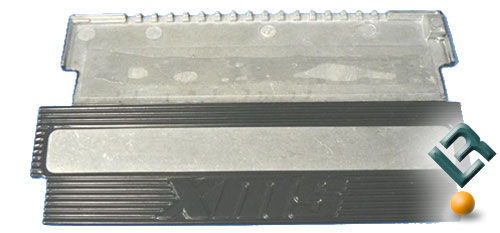Do Memory Heat Spreaders Make A Difference?
A Closer Look at the Corsair XMS Heat Spreaders
Since the DFI nF4 boards are the most popular overclocking boards for Athlon64s, and they also happen to support the high voltages required, we used one for our tests.
The Test System:
- DFI Lanparty nF4 Ultra-D (6-23 BIOS)
- Athlon64 X2 3800+ @ 1.55V, underclocked to 7x multiplier
- Zalman CNPS7000Cu heatsink/fan
- nVidia 6600GT 128MB PCI-E video card
We pumped the VDIMM to 3.4V, and ran the tests four different ways, all in an oven with an internal temperature of 68F to eliminate any differences in ambient temperature that might affect our outcome.
1) With the ?Mesh? Heat Spreader
We put the module on the board, and used the RST Pro2 card to test the memory. This is a specialized card that boots to its own ram test, more information can be found here: http://www.uxd.com/rstpro2.shtml With the ?Mesh? heatspreader, we were able to get a single module to 253 Mhz at 3.4VDimm, with 2-2-2-5 latencies at 1T command rate.
2) With the XMS Platinum Heatspreader

This is the stock heatspreader that Corsair uses, and we?ve been using it for a few years now. It?s crafted from two single pieces of aluminum, connected with a thin piece of thermally conductive tape, and clips together with a small wire clip pictured at top.
We removed the Mesh heatspreader and carefully applied our own to the module. After testing, we found that our maximum overclock was identical to the module with the Mesh heat spreader attached, 253 Mhz at 3.4V at 2-2-2-5 with 1T command rate.
3) With the XMS Pro Heat Spreader

The XMS Pro module heatspreader has 95% more surface area than standard memory heat spreaders, and is crafted from aluminum as well, cast in this case rather than stamped. The method of adhesion in this case is a much thinner piece of thermally activated adhesive. It is baked onto the module at high temperature to insure proper contact and adhesion.
The pro module performed slightly better than the XTC and XMS Platinum module. It took the memory to 254 Mhz at 3.4V, with 2-2-2-5 latency and 1T command rate.
4) No Heat Spreader
For a control group we tested the module with no heat spreader. The module was stripped of all heat spreaders and the thermal tape was cleaned off. The module would not clock higher than 250 Mhz at 3.4V with 2-2-2-5 latency and 1T command rate.

Comments are closed.